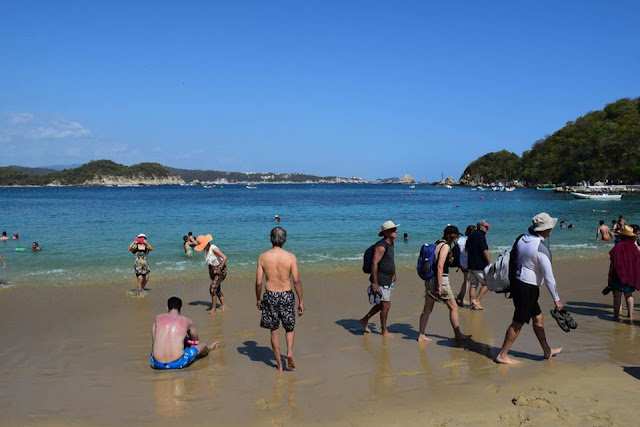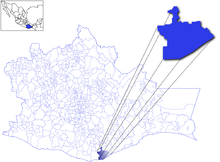 |
| Đến Huatulco rồi, biển đẹp quá |

dệt vải theo lối cổ truyền
hoa Phượng Mễ Tây Cơ
nhà thờ gần cảng
tự biên tự diễn
chờ xe đến đón đi tham quan các vùng phụ cận
Nhìn xuống vịnh
lên điỉnh núi nhìn xuống, ai cũng cười tươi
Trời xanh,biển rộng
Anh Đức chị Loan leo trên đá coi chừng té
đến tiệm ăn Langosta Gorda ở bãi biển
Đến nơi đi hors bord (outboard) và snorkeling (ảnh V.Lành)
bãi biển cát trắng mịn đẹp quá
Trước Grand Hotel có bãi biển đẹp
Trốn nắng
Dọc nước ấm chút thôi
trốn nắng
khách sạn có view tuyêt đẹp
trên đường đi La Crucecita
đến Cathedral của La Crucecita
Notre Dame de Guadeloupe
tour guide Jonathan đang giải thích
cũng có người VN ăn xin!
được thử rượu Mezcal địa phương
Mua 1 chai
phái nữ thử punch thôi
Huatulco
From Wikipedia, the free encyclopedia
- This article is about the tourist development. For the town and municipality, see Santa María Huatulco.
Location of Huatulco in Oaxaca
Huatulco (Spanish pronunciation: [wa'tulko]) (pronounced wah-TOOL-co) ("Bahías de Huatulco"), centered on the town of La Crucecita, is a tourist development in Mexico. It is located on the Pacific coast in the state of Oaxaca.
Huatulco's tourism industry is centered on its nine bays thus the name
Bahias de Huatulco but has since been unofficially shortened to simply
Huatulco. Huatulco has a wide variety of accommodations from rooms for
rent, small economy luxury hotels, luxury villas, vacation condominiums,
bed and breakfasts, as well as several luxury resorts standing on or
near the shores of Tangolunda Bay. The Camino Real Zaashila, Quinta Real
Huatulco, Las Brisas, Dreams Resort & Spa (Formerly the Gala hotel)
and the Barceló are examples of the most popular larger resorts in the
area.
Huatulco is located in the state of Oaxaca where the foothills of the Sierra Madre del Sur Mountains meet the Pacific Ocean approximately 500 km south of Acapulco, Guerrero.[1] The population is 50,000.
Contents
History
Legends say the Toltecs and Quetzalcoatl
came from this area. Quetzalcoátl, according to a later legend, set an
enormous and indestructible cross. Various people have passed through
this area, including the Chatmos, the Zapotecs and the Mexicas.[1]
After the Spanish Conquest, Huatulco thrived as a port under Hernán Cortés's
control serving as a vantage point for Spanish galleons and a
distribution centre for supplies on the Pacific coast. The latter half
of the 16th Century saw Huatulco attacked by Francis Drake and Thomas Cavendish - both of whom left their prints on the region's history and legends that continue to this day.[1]
Until resort development began in the 1980s, Huatulco was little known except as a coffee-growing area.[1]
In 1984, FONATUR (Fondo Nacional de Turismo), a government agency
dedicated to the development of tourism in Mexico, acquired 21,000
hectares of land to develop a tourism center, similar to that in Cancún. The existing population was relocated to Santa María Huatulco.[2]
The plan resulted in the improvement of roadways and other
infrastructure. It also has populated areas mixed with "green zones" to
make the area ecologically friendlier.[1]
In addition to the beaches, there are small communities of Bahias de Huatulco, such as Santa Cruz, La Crucecita, or old Santa María Huatulco
(the municipal seat). Transportation between the communities is
available by bus or taxi. The entire area has a "small town" feel about
it and is rarely crowded with tourists with the exception of the
Christmas and Semana Santa holiday periods.
Huatulco's Cacaluta Bay. Taken by: Rodrigo Coutiño Medina
About 80% of all tourism in Bahias de Huatulco is domestic in nature.
Only about 20% of Huatulco's tourism is foreign, mainly because
international air access is limited. Bahias de Huatulco has a small
international airport just 20 minutes from the main resorts in
Tangolunda Bay. This airport has recently increased tourism, and helped
to popularize the Pacific Coast backpacker route through Huatulco, Zipolite, Mazunte, and Puerto Escondido.The peak season for foreign tourism is typically from December through April.
Geography
Bahias de Huatulco is divided into four main districts. Tangolunda
is the area where the large upscale resorts are located; Santa Cruz is a
small town with the main marina and Santa Cruz beach; La Crucecita, is
another small town just inland from the beach area which provides
support services to the area, and Chahué is an area between Santa Cruz
and Tangolunda.[2]
The Bahias de Huatulco are a series of nine bays and numerous small
coves stretching along 26 kilometers of jagged coastline, including 36
white sandy beaches. The most centrally located bay is Bahía de Santa Cruz,
which is just south of the town of La Crucecita. It is also the center
of commercial and tourist activities, with a large pier where cruise
ships dock. Many resort offerings can be found here such as hotels,
craft shops, discothèques, bars, restaurants, excursion agencies,
sailboat excursions as well as scuba diving, snorkeling and jet skis for
rent. The Capilla de Santa Cruz is where many weddings and baptisms are celebrated next to the sea. Playa Santa Cruz, is the best known of the beaches here. It is 250 meters long, with soft white sand and turquoise blue water.[1]
Heading east from Santa Cruz are the bays of Bahía Chahué, Bahía Tangolunda and Bahía Conejos.
These are the more developed areas of Huatulco. Bahía Chahué is 2 km
east of Santa Cruz and its name means "fertile or moist land" in Zapotec.
It has a marina for large and small yachts along with three principal
beaches; Chahué, Esperanza and Tejón. Even though these are wide
beaches, their moderate surf makes them less-visited than those in Santa
Cruz. Three km east of Chahué is Bahía Tangolunda, which has five
beaches; Ventura, Manzanillo, Tornillo, Tangolunda and Rincón Sabroso.
Here the water varies between cobalt blue and emerald green. Most of the
larger hotels are located on this bay. Residencial Conejos is 4 km east
of Tangolunda and has some of the larger residential homes in the area,
some of which are vacation rentals. The mouth of the Río (River)
Copalita is slightly east of Bahía Conejos and it has a long zone of
beaches. To the east of Río Copalita are beaches stretching all the way
to the Isthmus of Tehuantepec.[1]
Two of these beaches are Barra de la Cruz and Playa Mojon. Some great
surf waves can be found from these beaches. Barra de la Cruz is one of
the best and easiest to access. Playa El Mojon can, at certain times of
the year, have some decent waves for surfing and is also a great
location to explore.
To the west of Santa Cruz, the beaches are less developed; in fact most of this area belongs to the Parque Nacional (National Park) Huatulco.
This is a protected area (Área Natural Protegida) created in 1998. It
contains 6,375 hectares of lowland jungle and 5,516 hectares of marine
areas, encompassing the bays of Bahía Maguey, Bahía Órgano, Bahía Cacaluta, Bahía Chachacual and Bahía San Agustín.
In these bays live the most important coral communities of the Mexican
Pacific. 723 species of animals live in the park as well as a number of
species of colorful fish, and it is open to scuba diving, bird-watching
and hiking. In 2005, Huatulco was awarded the Green Globe
International Certification as a sustainable tourist area. Huatulco was
the first sustainable tourist community in the Americas and the third
worldwide, after Bali in Indonesia and Kaikoura in New Zealand, to
receive this prestigious award because of its development programs for a
culture environmentally friendly to conserve its natural resources.
Bahía Órgano is named for the cacti that grow there. It is 240 meters
long and only accessible by boat. Bahía Maguey is about 1/2 km long and
is accessible by car. Both these bays have fine, white sand and waters
of various colors of blue and green. Bahía Cacaluta and Bahía Chachacual
are only accessible by boat, and there are absolutely no human
constructions of any kind. Bahía San Agustín is the furthest west and
the largest of all the bays. It has 1 km of beaches between 20 and 80
meters wide. There are also small islets inside the bay itself.[1]
Large portions of the Bahias de Huatulco resort area are located within
an "ecological zone"; much of the area is protected from future
development, and the area is serviced by modern water and sewage treatment plants so that no waste goes into its pristine bays. Huatulco has been awarded the Green Globe
certification, and it is the only resort in Mexico to receive this
prestigious award (Green Globe is the worldwide benchmarking and
certification system for the travel and tourism industry across the
triple bottom line of economic, social and environmental management).
Education
The Universidad del Mar has its campus in Huatulco.
Bocana del Río Copalita
The Bocana del Río Copalita is a 2,500-year-old archaeological site
located about ten kilometers from the bays, which is open to the public.
The name means "place of copal" and covers an areas of about thirty
five hectares. It is believed to have been on the border between Zapotec and Mixtec dominions. Landmarks of the site include a main temple, a temple dedicated to a serpent god, a Mesoamerican ball court and a site museum.[3]
Climate
Sunshine can be expected about 330 days a year with the average
temperature of 28 °C (82.4 °F). The dry season extends from December to
May and the rainy season is from June to November. The amount of
precipitation has a definite effect on the local vegetation, being
brownish in the dry season and very green in the rainy season.[1]
Coffee plantations
There are a number of coffee plantations which are still in operation and give tours, including Finca (farm) Las Nieves, Finca Monte Carlos, Finca Margaritas, Finca El Pacífico and Finca La Gloria.
Finca El Pacífico is known for the organic coffee it produces called
"Pluma Hidalgo," and it is surrounded by waterfalls and ravines. Finca
La Gloria is known for the butterfly sanctuary "Mariposorio Dain
Biguid", where dozens of species of butterflies can be seen and the
"Llano Grande Falls". The Río Copalitilla has its source here as well.[1]
Festivals
The Festival Música por la Tierra (Music Festival for the Earth)
features music and culture in an event designed to raise awareness about
the environment. The event features a number of rock and popular music
groups.[4]
Transportation
Despite the improvements in infrastructure, Bahias de Huatulco is not
as easy to get to as other resorts like Cancun. The drive south from
Acapulco on Federal Highway 200 has over 300 speed bumps. Driving from Oaxaca city, the state capital is not any easier because Federal Highway 175 is also full of speed bumps. Federal Highway 190 has fewer but it's a much longer road with many curves due to the mountainous terrain.[1]
Bahias de Huatulco has an airport, the Bahías de Huatulco International Airport, which is served nationally by Interjet, and Magnicharters, from other Mexican airports. Several airlines fly here from the U.S. and Canada.[1]
Huatulco's new International Airport (HUX), has increased tourism not only in Huatulco, but in other nearby beaches like Mazunte and Zipolite.
Every day flights arrive from Mexico City, bringing tourists to the
beach. This airport, and new road construction in Oaxaca have made
Oaxaca's Pacific coast an increasingly popular destination for Mexican
and International tourists as well.
References
- Quintanar Hinojosa, Beatriz (August 2007). "Huatulco". Guía México Desconocido: Oaxaca 137: 38–53.
- Akaike Garrido, Yuki (2010). Jiménez González, Victor Manuel, ed. Oaxaca: Guia para descubrir los encantos del estado [Oaxaca: Guide to discover the charms of the state]. Mexico City: Editorial Océano de Mexico, SA de CV. p. 24. ISBN 978-607-400-233-1.













































































































Aucun commentaire:
Enregistrer un commentaire